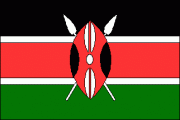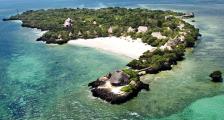General History
The country's history dates to the Stone Age, making Kenya one of the countries in the world that possesses the largest and most complete record of man's cultural development. This is partly because of the country's rich variety of environmental factors conducive to human survival and development. According to archeological finds in various parts of the country, the prehistoric period can best be described under two categories; the Stone Age period which dates from about 2 million years ago and Neolithic period from about 10,000 to 2000 years ago. Available evidence indicates that man left behind traces of his occupation during the iron age through the pre-colonial period and up to the present time. The phases of the various periods are characterized by tools ranging from crude to advanced much smaller ones and relevant to the respective lifestyles. The sites for the tools are widespread in Kenya.
History is however not specific on the exact type of inhabitants who occupied Kenya between this early period and the 19th century when the British colonized the country. Islamic immigrants started setting at the coast during the 8th Century. Portuguese followed and are among the first known European settlers along the coast. Up to the 19th Century, very little was known of the Kenyan hinterland until the arrival of the British who came and colonized Kenya.
The colonization process was met with resistance which was countered with excessive force. Hence, most of Kenya's modern history is marked by rebellions against the British, with the first one being in 1890 and the last one, known as Mau Mau rebellion in 1952. The outbreak of the Mau Mau paved the way for constitutional reforms and development in subsequent years. In 1955, a myriad of political parties were formed all over the country after the colonial Government yielded to their formation. Elections were held in March 1957, after which racial barriers in the Government began to be lifted.
By 1960, LEGCO had an African majority. In 1960, Kenya African National Union (KANU), which advocated for a unitary government was formed. In 1961, Kenya African Democratic Union (KADU) which advocated a quasi-federal government (Majimbo) was also formed. The first full franchise General Elections were held in May 1963 and KANU emerged the winner. In June 1963, Kenya attained internal self-government. On December 12th of the same year, independence was achieved with a complex Majimbo constitution which conceded much autonomy endence in 1964, Kenya became a Republic with Mzee Jomo Kenyatta as the President. Following his death on August 22, 1978, Hon. Daniel arap Moi assumed the Presidency in accordance with the Kenyan Constitution. He ruled Kenya for 25 years. Following a general election held in 2002, Hon. Mwai Kibaki, the third President of the Republic of Kenya took office on 30th December 2002.
Flag
 The color black represents the people of the Republic of Kenya, red for the blood shed during the fight for independence, green for the country's landscape and the white lines were added later to symbolize peace and honesty. The black, red, and white traditional Maasai shield and two spears symbolize the defense of all the things mentioned peace and honesty.
The color black represents the people of the Republic of Kenya, red for the blood shed during the fight for independence, green for the country's landscape and the white lines were added later to symbolize peace and honesty. The black, red, and white traditional Maasai shield and two spears symbolize the defense of all the things mentioned peace and honesty.
Location
Kenya lies across the equator on the East Coast of Africa. It borders Somalia, Ethiopia and Sudan to the North, Uganda to the west, Tanzania to the South and the Indian Ocean to the East. (see map)
Area
Covers an area of 225, 000 sq miles (582, 646 sq km) approximately the size of Texas State, U.S.A.
Administrative Divisions
Eight Provinces including the Nairobi area. Provinces are: Central, Coast, Eastern, North Eastern Province, Rift Valley, Western and North Eastern. These provinces are divided into administrative areas known as districts.
Climate
Pleasant and favourable with plenty of sunshine all year round. Rainfall is sometimes heavy around April to May while some areas are more cloudy though without much rain around July/August.
Population
According to the national population and housing census report of August 1999, Kenya’s population is estimated to be 28,808,658.
Religion
40 % Protestant, 30 % Roman Catholic, 6 % Muslim, 23% other religions.



